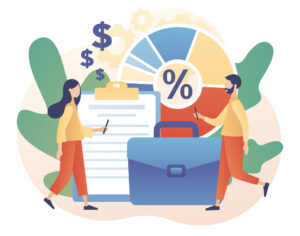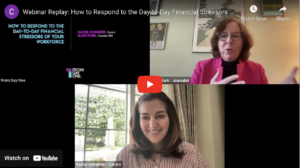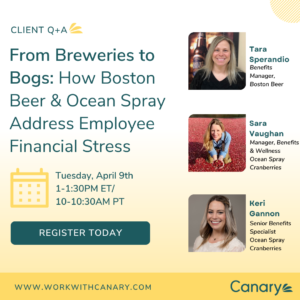By Rachel Schneider, Canary CEO

My co-founders, Kimberly Gartner and Aliza Gutman, and I launched Canary to create a new type of fund, the Grant Circle – seeded by both employers and employees – that provides cash grants to employees in moments of need. Sometimes, in spite of our best efforts, there are times when any of us can come up short. It could be because something big and unexpected happens, like an illness or a death in the family, or it could be the normal ups and downs of life. But, in those moments, we turn to our community for help. Our friends, family, coworkers, and employers step up and chip in. We wanted to make it easier for them to do so, and we wanted to make it easier for people to ask for help with dignity.
What we didn’t expect, of course, was that we would be launching the Grant Circle platform during a pandemic.In early 2020, we had just completed two proof of concept tests with employers and were in the midst of a redesign. When much of the U.S. went on lockdown in March, our tech team (thank you ThinkNimble!) accelerated our work so that we could launch Grant Circles with four employers in April.
What we’ve seen since then is both heartwarming and heartbreaking.
We heard from Anne (name changed), who had received an eviction notice just weeks before the birth of her child. Anne and her husband had both been unable to work because of COVID-19. Their intense financial stress contributed to Anne’s rising blood pressure, which their doctor was concerned would result in preeclampsia. When she was approved for a Grant Circle grant, Anne paid their rent, avoided eviction and bought a month’s worth of groceries. Anne said to us: “I cried of relief when my grant was approved. My husband cried, too. We were so relieved that we would not be on the street and that we would be able to get food for our kids.”
We heard from Pam, who had taken an unpaid leave of absence to help her elderly mother recover from surgery. When COVID-19 made it impossible to return to work, she didn’t know what she was going to do about her mother’s mounting medical bills and her own mortgage. An email about the Grant Circle showed up just in time. Pam said,
“The day I received the Grant Circle funds was a big day for me that I will never forget. It was like I was drowning and someone came out to save me.”
In the 2.5 months since these Grant Circles have launched, a lot of what we’ve seen is what you would expect. Almost three quarters of the grant requests that we’ve received are related to loss of income due to COVID-19. Because the maximum grant for most of our clients is $1,000, and because the economic fall-out from the pandemic is ongoing, few people report that this money is sufficient for them to get entirely back on their feet. That said, the grants are absolutely helping. People report feeling less stressed, having breathing room to figure out their next steps, and being able to avoid late fees and shut-off of services like telephone, internet and utilities, as well as other more dire consequences like rising debt burdens, poor health outcomes or eviction.
The grants also make people feel good about their employers. We heard statements like, “I’m so thankful to be part of a company that stands beside you during such hard times,” and (in the heartwarming AND heartbreaking category),
“I have never worked in a place where an employer has cared about my wellbeing, and I was touched when they offered the Grant Circle as a way to support us.”
What may be more surprising for many people is how similar these stories and sentiments are to what we saw in the Grant Circles that we ran in Fall 2019. Even then, at the height of the U.S. economy’s strength and in spite of historically low unemployment numbers, over half of the grant applications that we received cited loss of income as an event precipitating the grant request. Even then, what people needed to spend the money on was basic living expenses: food, utilities, rent. Even then, what people described when talking about why they needed the grant was a feeling of drowning, followed by feelings of relief and of gratitude when they received the funds.
The way that COVID-19 has torn through our society has made the financial fragility that many people live with painfully clear. That clarity gave rise to immediate and extraordinary generosity. Philanthropic foundations and individuals stepped up, raising billions of dollars through tens of thousands of relief campaigns. Even in the small fundraising campaigns conducted as a part of our Grant Circles, the number of people contributing funds was greater than the number of people requesting grants.
However, for millions of Americans, this financial fragility was here before the pandemic, and it will be here afterwards. Financial fragility is not purely the result of a massive, but hopefully short lived, spike in unemployment. It is the result of low wages and insufficient benefits for workers, combined with the high and rising cost of living. It is the result of volatile earning and spending needs, as Jonathan Morduch and I wrote about in The Financial Diaries. It is the result of the generations of injustice that have led white household wealth to be seven times greater than Black or Hispanic household wealth, which means that even though family and friends stretch as much as they can to help each other, communities of color have fewer resources with which to do so.
The heartbreak of financial fragility will not disappear when COVID-19 does, but nor will our heartwarming instinct to help each other. In this rare moment when our nation is taking a forced collective pause, long-ignored inequalities are being brought into the spotlight. We have an opportunity, right now, to not only reflect on the systems that keep people down but also to work on solutions that help people rise up. Now is the time to invest in infrastructure that will outlive the pandemic and that will help us continue to help each other.






